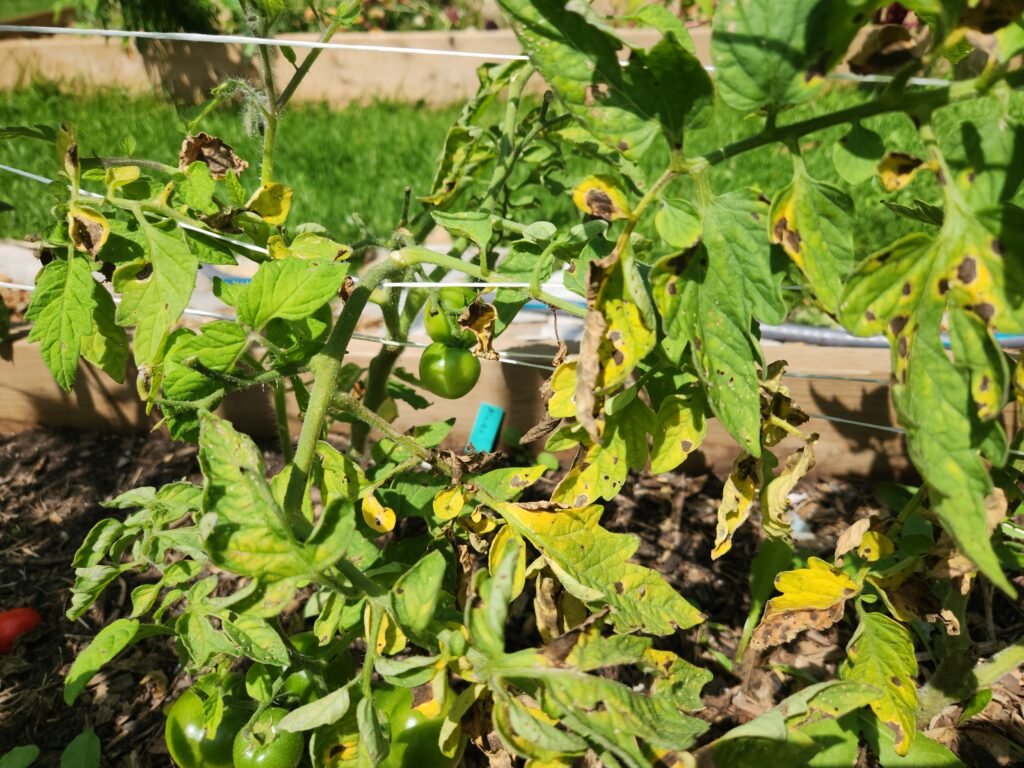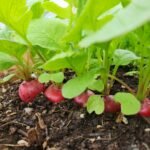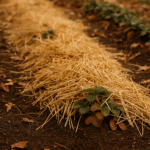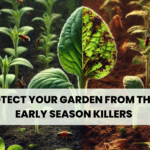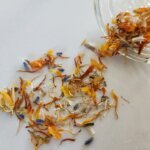Whether you are an experienced gardener or just starting out, when you plan your garden the tomatoes are always on your list. It was the first thing we picked up when we bought our first seeds. Little did we know how many tomato diseases these common garden fruits could have.
This post contains affiliate links. If you use these links to buy something we may earn a commission. Thanks.
In this post I will take you through the most common tomato issues and ways to prevent or remedy them. Some can be cured, but most need to be minimized the best you can.
Sometimes it can be hard to identify exactly what is the cause of your tomatoes issues, but we’ll do our best to help you identify them. Check out our how to grow tomatoes guide for in depth steps on successfully growing tomatoes.
Four Main Tomato Diseases Are:
There are definitely more issues with tomatoes that just these four, but these are the main ones we see in our garden. If there is another main one you want us to add please let us know in the comment section below.
Why Are My Tomatoes Splitting?
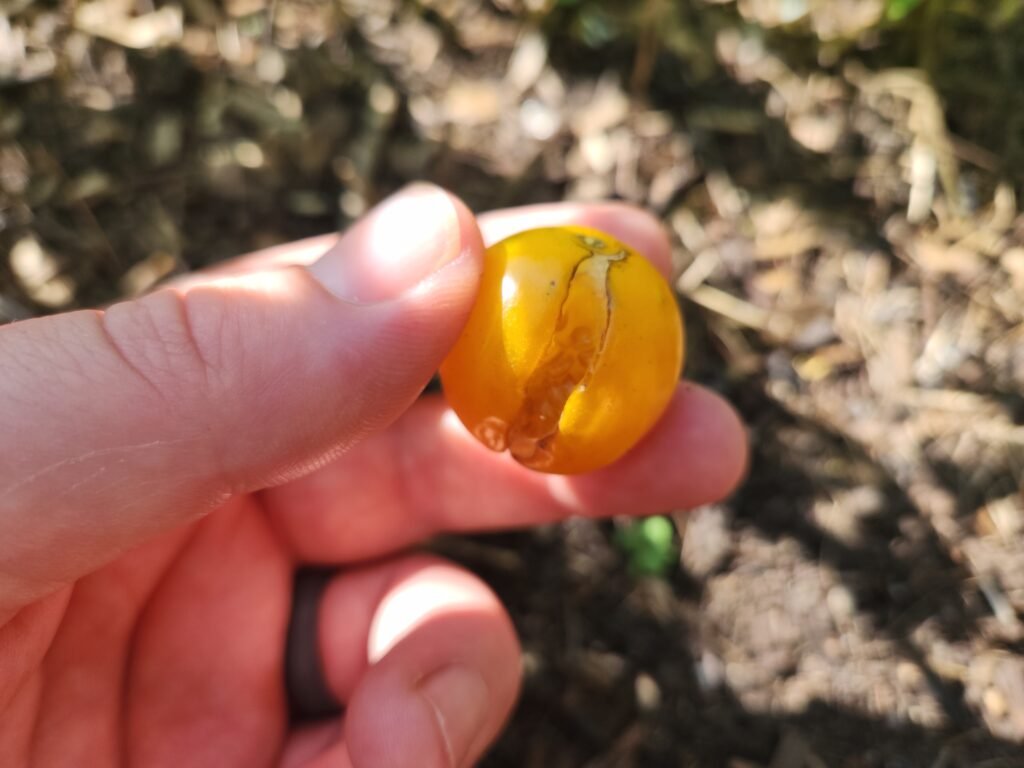
Having a tomato split apart while it’s still on the vine can be heartbreaking. You watch the tomato grow from a flower to it’s full size. Then it looks like it is ripening and when it’s almost done, BAM! It splits open.
We’ve had issues with splitting tomatoes every year. There are ways to minimize it happening, which I’ll get into shortly. But it always seems to happen at least a few times.
What Causes Tomato Splitting?
The main cause of tomato splitting is when they receive a lot of water after a dry spell. After the tomato receives the abundance of water it tries to grow to fast for the outer skin which causes the split.
How To Prevent Tomato Splitting?
One way to help prevent tomatoes from splitting is to water them evenly and consistently. This will help your tomatoes because they won’t go from dry conditions to a sudden surge of water.
Another way to prevent tomato splitting is to harvest your tomatoes as soon as they start to blush and ripen. A tomato is more susceptible to splitting when it is ripening and finished growing. The outer skin gets softer and therefore splits easier.
What Is Tomato Blight?
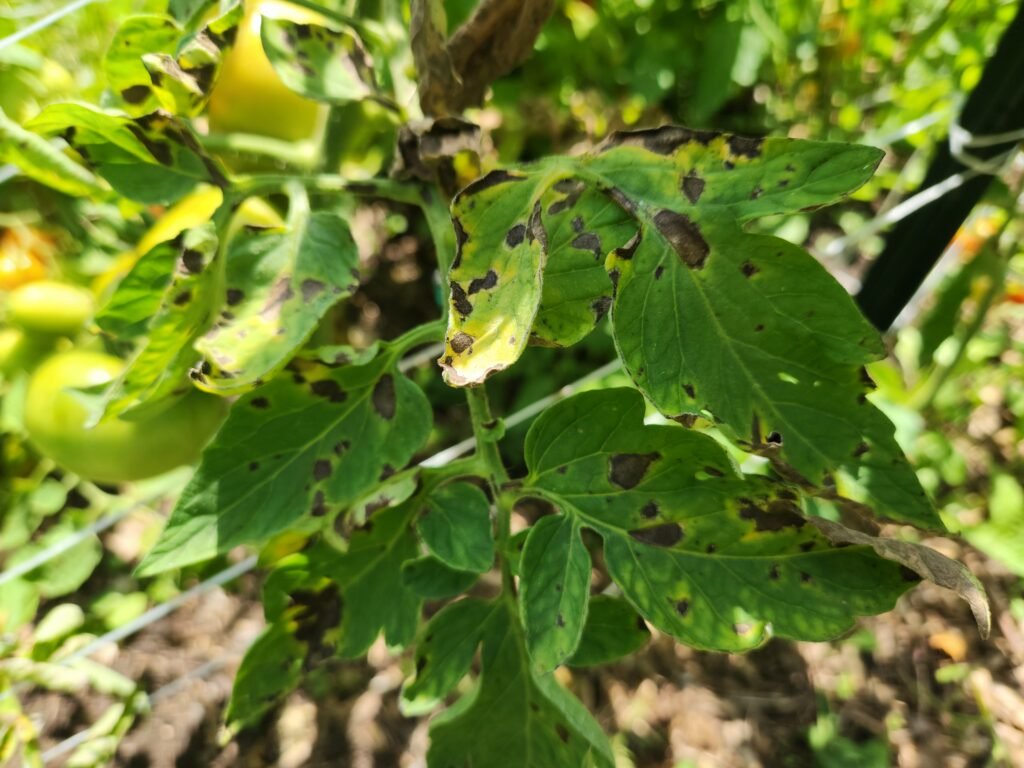
Blight is another very common tomato issue gardeners face. It is a disease that attacks both the leaves and the fruit of tomatoes. It also affects potatoes.
Blight is most common when the weather is wet and warm. We’ve seen it on our tomatoes starting at the end of July. Especially if we are seeing a lot of rainfall.

How To Minimize Tomato Blight?
There are several ways we can try to reduce the amount of blight we see in our gardens.
Crop Rotation
This is the first line of defense when you see blight in your garden. Rotating your crops to a different part of the garden could help prevent blight that might overwinter in your garden beds.
Plant Spacing
Spacing your tomatoes far enough away from each other to increase airflow can help reduce the likelihood of developing blight in the first place.
Catching Blight Early
Inspect your tomato plants regularly and if you see any sign of blight remove the affected leaves or fruit immediately.
Prune Your Tomatoes
This goes hand in hand with the plant spacing and catching blight early. Blight tends to start at the bottom of the plants closest to the soil. Removing low hanging leaves with clean garden pruners will increase airflow and lower the chance of blight. Always remove any leaves that show signs of blight.
What Is Blossom End Rot?
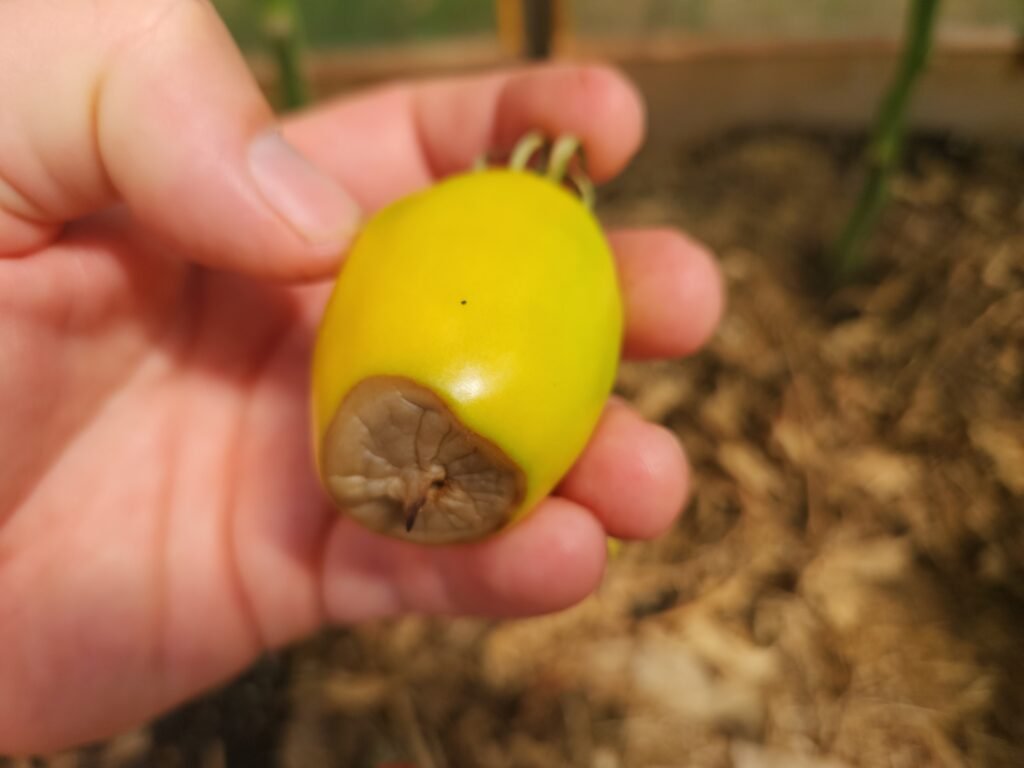
Blossom end rot is a issue with the bottom (blossom) end of the tomato. It can either be a sunken in section like in the picture above or it could keep the nature shape of the tomato but end up turning grey or black.
What Causes Blossom End Rot?
A lot of people thing blossom end rot is another fungal disease affecting tomatoes. In fact, blossom end rot is caused by a lack of calcium in the tomato.
This could be cause by low calcium levels in the soil but most of the time it is caused by improper watering. Either infrequent watering or a long drought can cause blossom end rot to occur.
In my personal opinion and experience, I believe blossom end rot is more likely to occur in elongated tomato varieties, like the very common Roma tomato variety. We’ve had multiple plants that were all watered and fertilized the same, but one variety called “Big Mama” (which is an elongated tomato) always seems to get blossom end rot.
How To Prevent Blossom End Rot?
Like I said above, blossom end rot is caused by a lack of calcium and most of the time it is an inconsistent watering schedule that is the main culprit.
The best way to prevent blossom end rot is the follow a watering schedule and use mulch to cover the soil to prevent any prolonged dry spells.
Can You Eat A Tomato With Blossom End Rot?
The simple answer is, yes. The rotted section of the tomato can be cut off and the rest of the tomato can be eaten but the flavour might not be the same as a healthy fruit.
What Is Anthracnose Of Tomatoes?
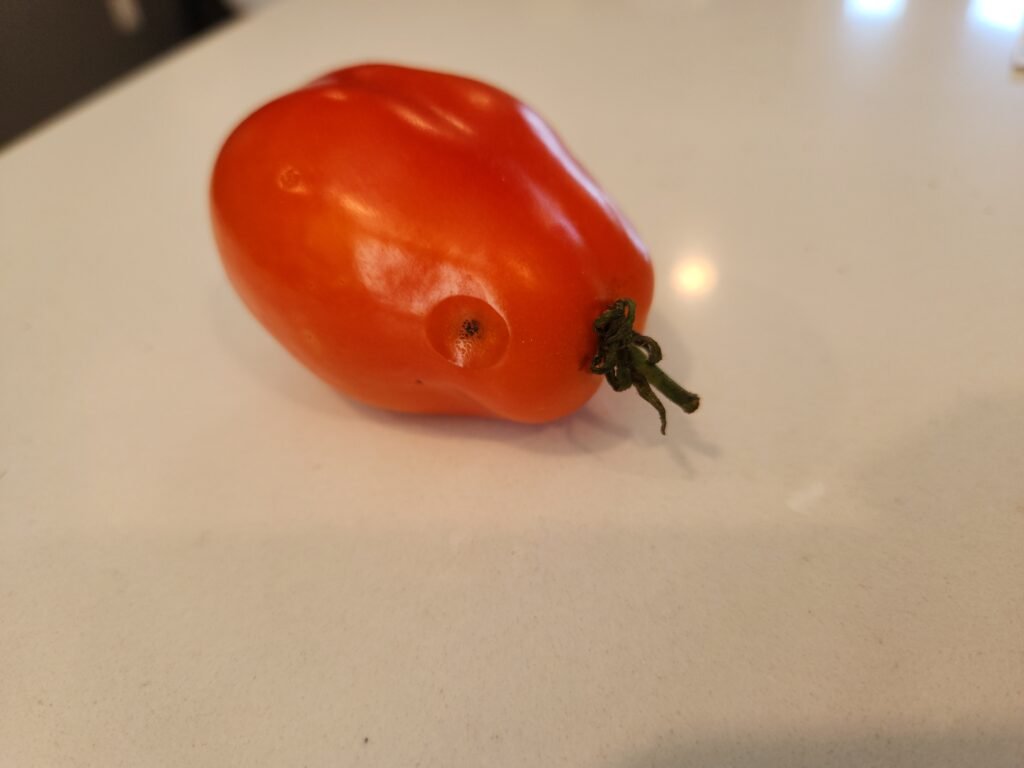
Anthracnose is a slightly less common issue for tomatoes but when you get it, it is hard to get rid of. This disease starts out as small depressions in the tomato skin on ripe and ripening tomatoes.
It then quickly becomes larger and develops a black spot in the middle, which grows as the depression does.
How To Prevent Anthracnose?
Anthracnose lives on the ground mainly in dead leaf litter. The best way to prevent Anthracnose is by crop rotation.
Another way to help prevent Anthracnose from affecting your tomatoes is by keeping your plants staked and off the ground. Anthracnose can be spread by rainfall that splashes off the soil and up onto your plants.
Can You Eat A Tomato Affected By Anthracnose?
A tomato affected by anthracnose can still be eaten as long as the spots are still small and easily removed. Cut around the lesion and remove a good chunk of the flesh and the rest of the tomato can be eaten.
Helpful Articles to Help You Grow Tomatoes Better:
- How To Grow Tomatoes From Seed To Harvest.
- A Simple Way To Save Tomato Seeds
- Tomatoes: A Weed or Invasive Species?
- When and How to Transplant Tomato Seedlings
- The 3 Best Companion Plants For Tomatoes
Frequently Asked Questions About Tomato Diseases
Why are my tomato leaves turning yellow?
Yellowing leaves on tomato plants can indicate several issues, including over-watering, nutrient deficiencies (especially nitrogen), or the early stages of disease like blight. It’s important to inspect the plant and soil conditions to narrow down the cause.
Can I grow tomatoes in containers to avoid some of these problems?
Yes, container gardening can help reduce certain issues like soil borne diseases, especially if you’re using fresh potting mix. Just make sure your containers are large enough, have good drainage, and are watered consistently.
Should I remove damaged or diseased tomatoes from the plant?
Yes, removing diseased or damaged tomatoes can help prevent the spread of issues like blight or anthracnose. It also allows the plant to focus energy on healthy fruit production.
Is it okay to compost diseased tomato plants?
It’s not recommended. Composting diseased plant material, especially with blight or anthracnose, can introduce pathogens back into your garden. It’s better to dispose of infected plants in the trash or burn them if permitted.
How do I tell the difference between a disease and a pest problem?
Diseases often cause leaf spots, discoloration, or fruit rot. Pest issues may leave behind chewed leaves, holes, or visible insects. Checking both the tops and undersides of leaves regularly can help you detect the difference early.
Conclusion:
Whether you’re growing heirlooms or hybrids, tomato issues are something every gardener faces eventually. The key is knowing what to look for, taking preventative steps, and learning from each season. With a bit of observation and care, your tomato plants can still produce delicious, healthy fruit even in the face of setbacks.
We hope you enjoyed this guide. If you did make sure you check out the other growing guides, seed saving guides, recipes, and join our mailing list for seasonal updates and homestead hacks. We are growing our website with more articles all the time, and we invite you to grow with us. If you have any questions about tomato issues or want to share your expertise, feel free to leave a comment below. Thanks for growing with us!

